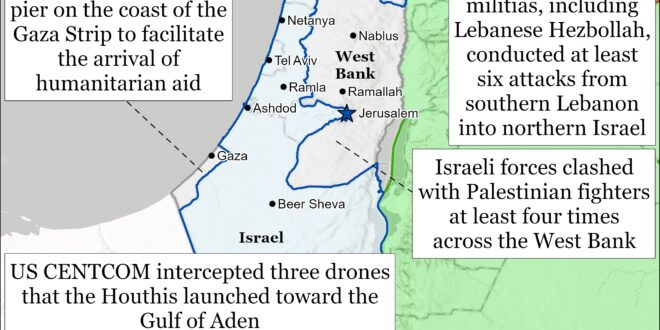The United States will construct a temporary pier on the coast of the Gaza Strip to facilitate the arrival and distribution of humanitarian aid. US President Joe Biden said during the State of the Union address on March 7 that he ordered the US military to lead an “emergency mission” to establish the pier.[1] Biden stressed that US servicemembers would not operate on the ground in the Gaza Strip. The United States will conduct a Joint Logistics Over-the-Shore (JLOTS). A JLOTS involves creating a floating pier for ship-to-shore operations.[2] The Pentagon press secretary said that the pier will be able to receive two million meals per day.[3] The secretary also noted that the pier facilities could take two months to become fully operational and will require up to 1,000 US military personnel to complete it.[4] Biden told reporters on March 8 that Israel would secure the temporary pier.[5] Thousands of Palestinians have surrounded aid shipments in the past, which underscores the need for security to ensure the fair, safe, and organized distribution of aid.[6]
The European Union announced on March 8 that it is planning to open an emergency maritime aid corridor from Cyprus to the Gaza Strip sometime between March 8 and 10 as part of a joint effort with its allies, including the United States.[7] The EU and the Cypriot Government said that all the efforts to open a maritime corridor will be “closely coordinated with Israel.”[8] The Israeli Foreign Ministry spokesperson welcomed the maritime corridor plan, noting that the aid must go through ”security checks…in accordance with Israeli standards.“[9] An anonymous Israeli official said that under the latest plan, UAE-donated aid would first go to Cyprus. Unspecified authorities would then inspect the aid before ships transport it to the Gaza Strip coast.[10]
CENTCOM commander Gen. Michael Kurilla said that US forces have not deterred the Houthis during a Senate Armed Services Committee Hearing on March 7.[11] Kurilla added that in his estimation, the United States will need to impose a ”cost” on Iran to stop the Houthis from continuing attacks.[12] Kurilla highlighted the importance of targeting Iran’s ability to resupply the Houthis.
Kurilla also said that US airstrikes on February 2 and February 7 deterred Iran or its proxies and partners from continuing attacks on US forces in Iraq and Syria. Kurilla reported that there has not been an attack on US forces in Iraq or Syria in 32 days.[13] US forces struck 85 Iranian-backed targets in Iraq and Syria on February 2 and killed a senior Kataib Hezbollah commander in Baghdad on February 7 who was responsible for the deaths of US servicemembers. Kurilla emphasized that deterrence is temporary.[14] Iranian-backed militias have conducted attacks targeting US service members prior to October 7. Iranian-backed militias in Iraq can resume attacks at a time, place, and for reasons of their choosing, as CTP-ISW has previously noted.[15] ran has continued to send arms and funds to its militias despite the pause in attacks.
Kurilla also said that Iran continues to support Hamas, Lebanese Hezbollah and armed groups in the West Bank.
Key Takeaways:
Gaza Strip: The United States will construct a temporary pier on the coast of the Gaza Strip to facilitate the arrival and distribution of humanitarian aid.
The European Union announced that it is planning to open an emergency maritime aid corridor from Cyprus to the Gaza Strip sometime between March 8 and 10 as part of a joint effort with its allies, including the United States.
US Military Operations in the Middle East: CENTCOM commander Gen. Michael Kurilla said that US forces have not deterred the Houthis during a Senate Armed Services Committee Hearing. Kurilla also said that US airstrikes on February 2 and February 7 deterred Iran or its proxies and partners from continuing attacks on US forces in Iraq and Syria. Kurilla emphasized that deterrence is temporary.
Northern Gaza Strip: The Israel Defense Forces conducted a clearing operation to reclear Beit Hanoun in the northern Gaza Strip.
Iran: Iranian Foreign Affairs Minister Hossein Amir Abdollahian discussed the Israel-Hamas war with Omani Foreign Affairs Minister Badr al Busaidi.
Southern Lebanon and Golan Heights: Israeli news reported that the IDF ordered Brig. Gen. Moshe Tamir to draft plans for a possible Israeli ground operation into southern Lebanon.
Yemen: US CENTCOM intercepted three drones that the Houthis launched toward the Gulf of Aden.
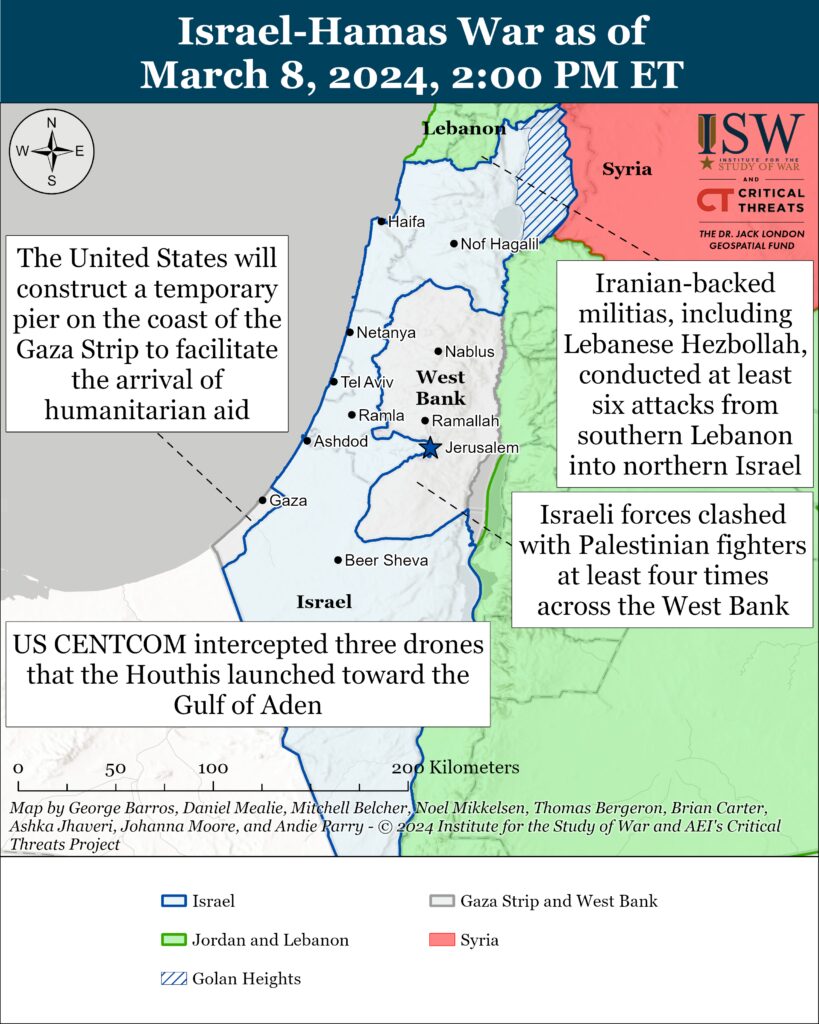
Gaza Strip
Axis of Resistance campaign objectives:
Erode the will of the Israeli political establishment and public to launch and sustain a major ground operation into the Gaza Strip
Degrade IDF material and morale around the Gaza Strip.The Israel Defense Forces (IDF) conducted a clearing operation to reclear Beit Hanoun in the northern Gaza Strip. The IDF Kfir Brigade’s Netzah Yuhda Battalion (143rd Division) operated in Beit Hanoun during the last week, engaging Palestinian fighters and destroying military infrastructure, including tunnel shafts.[16] The Kfir Brigade previously operated in the Gaza Strip but withdrew in January 2024.[17] The IDF said on December 18, 2023, that it had destroyed Hamas’ Beit Hanoun Battalion after conducting a nearly two-month-long clearing operation in the area.[18] Hamas exploited Israeli withdrawals in late December 2023 to infiltrate areas that Israeli forces had previously cleared and reconstitute some of its militia units. CTP-ISW has observed Palestinian fighters active in Beit Hanoun four times in March. CTP-ISW only observed Palestinian fighter activity once in February.[19] Palestinian fighters in Beit Hanoun have operated a drone near Israeli forces, attempted to establish a reconnaissance position, and shot at Israeli forces since February.[20]
The IDF Nahal Brigade (162nd Division) continued to conduct clearing operations in the central Gaza Strip on March 8.[21] Israeli forces killed 15 Palestinian fighters with sniper fire, tanks, and airstrikes.
Israeli forces continued to conduct clearing operations in some areas of northern Khan Younis on March 8. Three IDF brigades engaged Palestinian fighters in Hamad neighborhood, northwestern Khan Younis.[22] Palestinian fighters have been conducting a deliberate defense of Hamad since Israeli forces advanced into the neighborhood on March 3.[23] The IDF had intelligence that Palestinian fighters retreated from other areas in Khan Younis to hide in Hamad.[24] Palestinian fighters claimed most of their attacks in the Gaza Strip on March 8 in Hamad.[25] The IDF Bislamach Brigade continued offensive operations in Qarara, northern Khan Younis, and located tunnel shafts.[26] Hamas’ Qarara Battalion, which is in the Khan Younis Brigade, remains combat effective.[27]
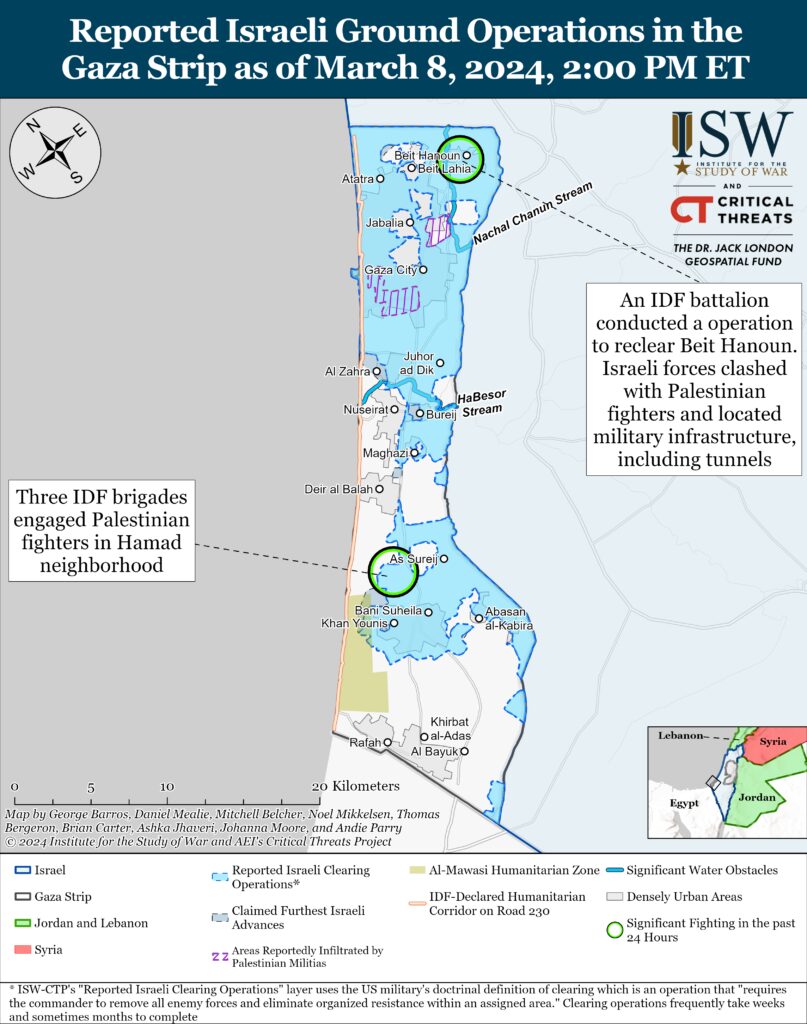
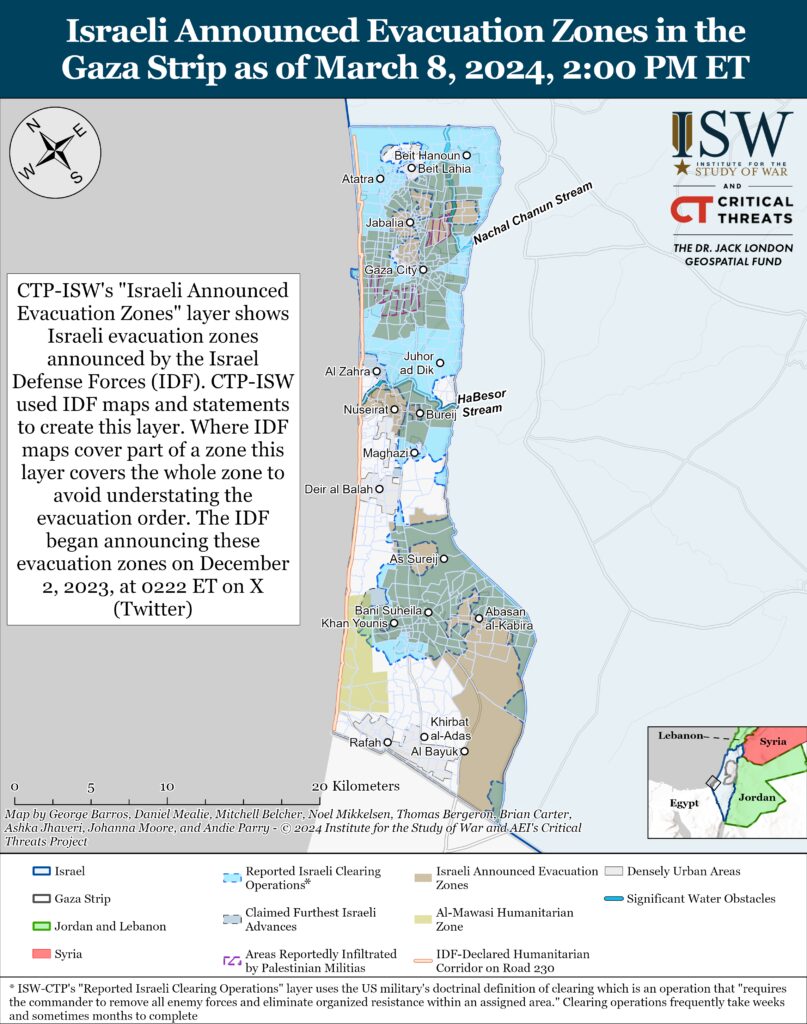
Israeli media reported on March 8 that Israeli officials have discussed arming civilians in the Gaza Strip to provide security for aid convoys.[28] Local police are refusing to provide security for the convoys because of Israeli airstrikes targeting members of Hamas’ police force. Israeli Prime Minister Benjamin Netanyahu postponed a decision on arming civilians. The United States has warned Israel that a “total breakdown of law and order” is exacerbating the humanitarian crisis in the strip.[29] The absence of a local security force contributes to this issue.[30]
A Palestinian journalist reported on March 8 that local tribal committees in the Gaza Strip agreed to ensure the safe passage of aid trucks in eastern Rafah after “local authorities” requested them to do so.[31] These ”local authorities“ are very likely Hamas. Hamas relies on its local police system to maintain social control. The IDF has targeted Hamas’ police and internal security apparatus to disrupt Hamas’ attempts to rebuild its governing authority in the Strip.[32] The Civil Police and the Hamas-controlled Interior Ministry’s Internal Security Forces in the Gaza Strip both employ fighters from the Hamas military wing.[33]
Palestinian fighters have conducted one indirect fire attack from the Gaza Strip into southern Israel since CTP-ISW’s last data cut off on March 7.[34] PIJ claimed responsibility for the rocket attack.[35] The IDF 215th Artillery Brigade (162nd Division), which has been targeting Palestinian militia positions and assets in the northern Gaza Strip, shelled the areas from which Palestinian fighters fired rockets targeting southern Israel on March 7.[36] The IDF destroyed a weapons depot, tunnels, and a rocket launcher.
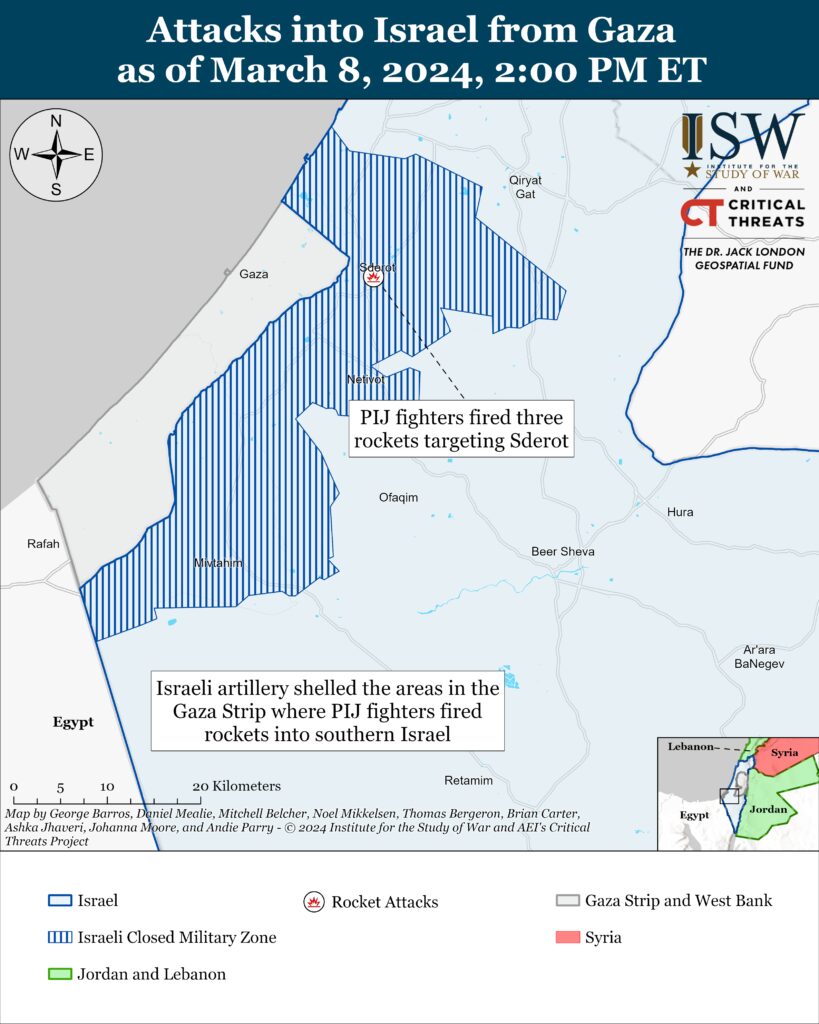
Recorded reports of attacks; CTP-ISW cannot independently verify impact.
West Bank
Axis of Resistance campaign objectives:
Draw IDF assets and resources toward the West Bank and fix them thereIsraeli forces have clashed with Palestinian fighters at least four times across the West Bank since CTP-ISW’s last data cut off on March 7.[37] The al Aqsa Martyrs’ Brigades conducted a complex attack targeting Israeli forces near Homesh, south of Jenin.[38] Al Aqsa Martyrs’ Brigades fighters first fired at an IDF outpost. The fighters then ambushed IDF reinforcements responding to the attack with small arms and rudimentary improvised explosive devices. A complex attack uses more than one type of weapon types, such as IEDs and direct fire weapons, to target opposing forces.
Hamas claimed that attacks targeting Israeli forces and Israeli settlers in the West Bank will intensify during Ramadan.[39]
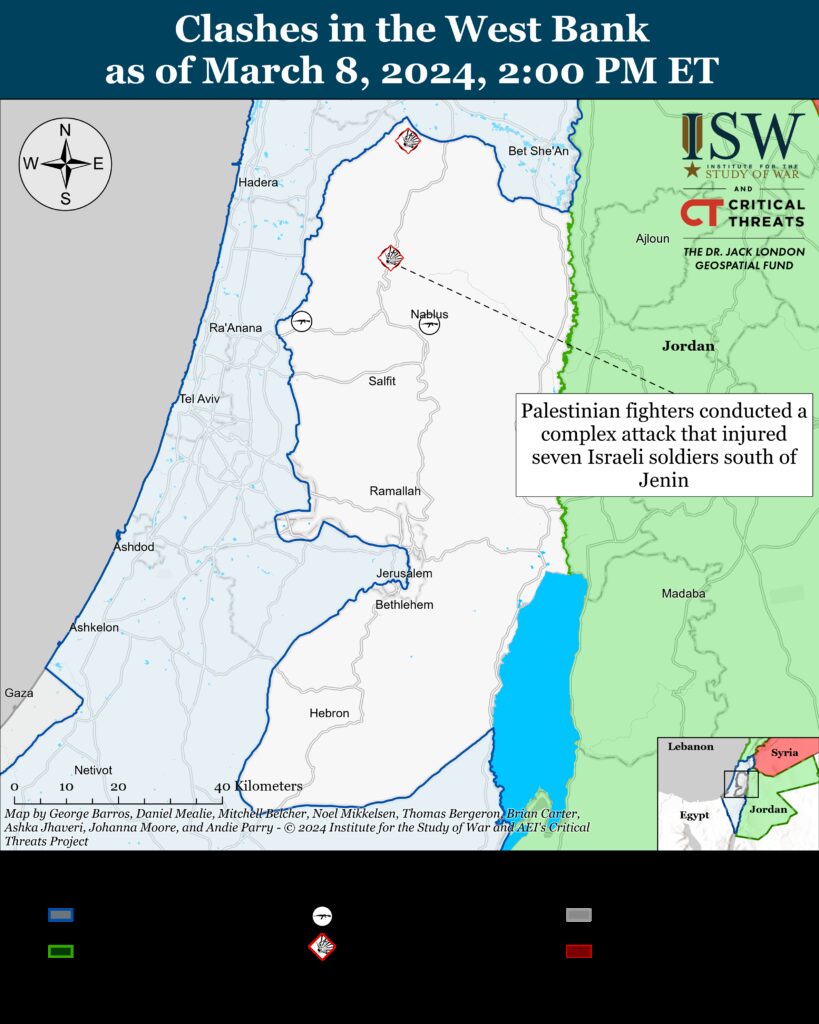
This map is not an exhaustive depiction of clashes and demonstrations in the West Bank.
Southern Lebanon and Golan Heights
Axis of Resistance campaign objectives:
Draw IDF assets and resources toward northern Israel and fix them there
Set conditions for successive campaigns into northern IsraelIranian-backed militias, including Lebanese Hezbollah, have conducted at least six attacks from southern Lebanon into northern Israel since CTP-ISW’s last data cutoff on March 7.[40] Hezbollah claimed six total attacks.[41] The IDF said it intercepted a Hezbollah one-way attack drone that entered Israeli airspace on March 7.[42]
Israeli news reported that the IDF ordered Brig. Gen. Moshe Tamir to draft plans for a possible Israeli ground operation into southern Lebanon.[43] Israeli forces will reportedly use multiple entry points during a ground operation and seek to push Hezbollah forces 10 kilometers north of the Israel-Lebanon border. An operation that only pushes Hezbollah forces 10 kilometers from the Israeli border does not reach the Litani River. UNSC Resolution 1701, which ended the 2006 Lebanon War, stipulates that Hezbollah cannot maintain military positions south of the Litani River.[44] Tamir formerly served as the commander of the Golani Brigade (36th Division) and drafted the IDF’s clearing operation plans for the Gaza Strip.
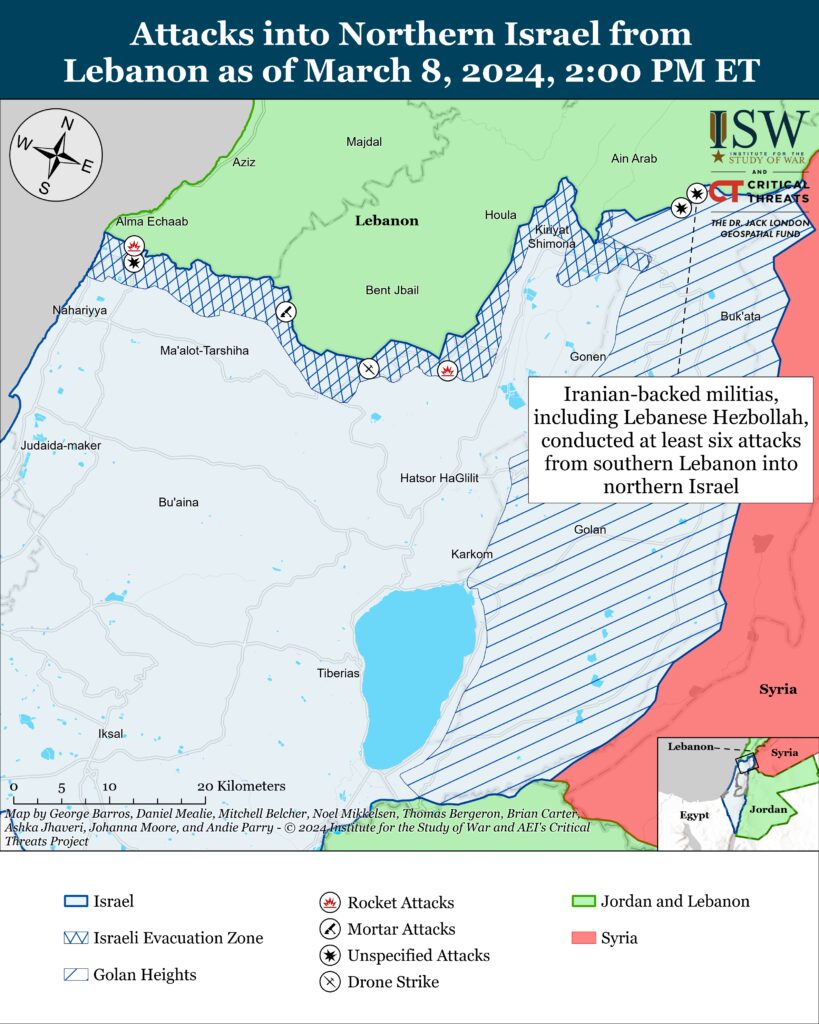
Recorded reports of attacks; CTP-ISW cannot independently verify impact.
Iran and Axis of Resistance
Axis of Resistance campaign objectives:
Demonstrate the capability and willingness of Iran and the Axis of Resistance to escalate against the United States and Israel on multiple fronts
Set conditions to fight a regional war on multiple frontsIranian Foreign Affairs Minister Hossein Amir Abdollahian discussed the Israel-Hamas war with Omani Foreign Affairs Minister Badr al Busaidi in a telephone call on March 8.[45] Abdollahian and Busaidi discussed the need for Muslim countries to pressure Israel to end the war. Abdollahian accused the United States of acting in “bad faith” during negotiations aimed at lifting unspecified sanctions on Iran. Iranian President Ebrahim Raisi said in September 2023 that Oman would facilitate future nuclear negotiations between Iran and the West.[46]
US CENTCOM intercepted three drones that the Houthis launched toward the Gulf of Aden on March 7.[47] CENTCOM confirmed that its forces separately conducted preemptive strikes targeting four mobile anti-ship cruise missiles and one drone in Houthi controlled areas of Yemen on March 7. Houthi-affiliated media confirmed that the strikes on March 7 struck areas in Hudaydah.[48]
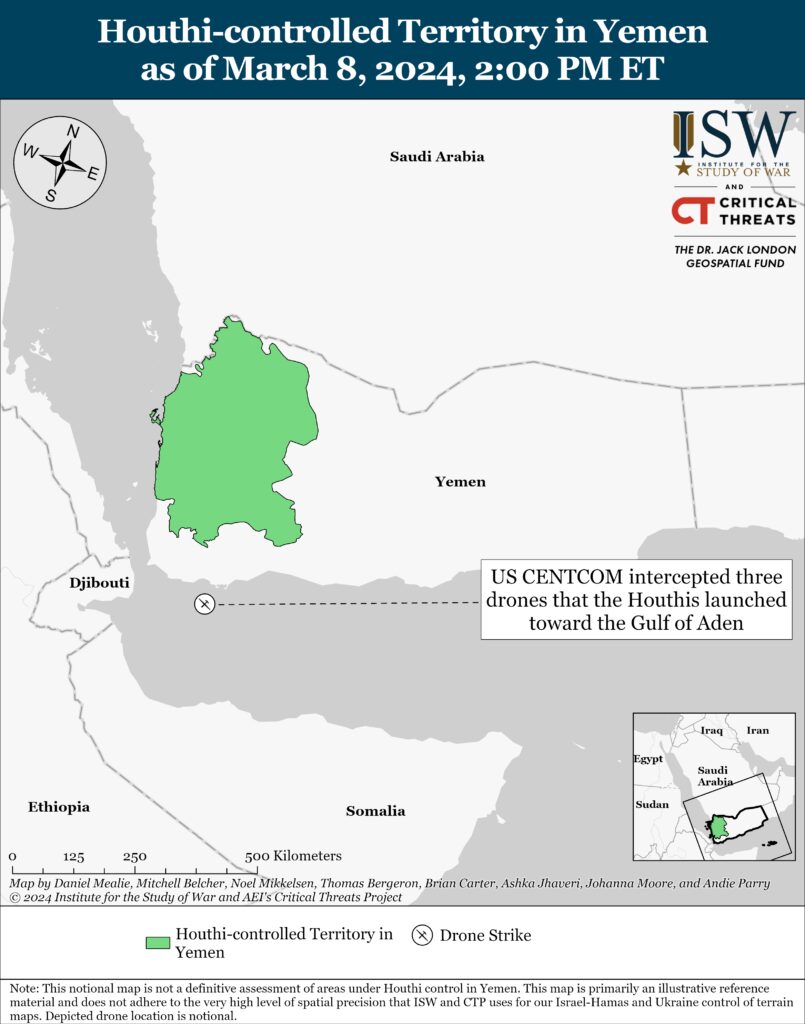
 Eurasia Press & News
Eurasia Press & News
